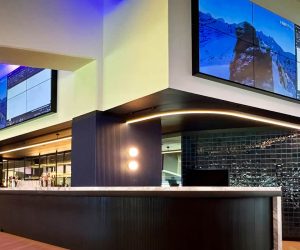
Whatever Happened to the Happy Ending?
Why do so many AV projects end acrimoniously? Pete Swanson has a plan to wipe away the tears.
There’s a tragically accurate maxim in the world of software development that the first 90% of a project accounts for 90% of the allocated time, while the remaining 10% accounts for the other 90% of the allocated time. Indeed for me, right now, the biggest problem we seem to face in the AV industry is the challenge of delivering projects to totally unrealistic deadlines.
Sure, tricky technology, the endless search for experienced new staff, the digital domain and other elements, conspire to make our lives that little bit harder, but the thing that really gets people prodding me in the chest (mostly metaphorically) is how on earth we get enough time at the end of a project to successfully commission systems.
This is not a new problem. I remember the same things happening when I started in the industry in the ’90s and I’m sure those with more years on me could attest to the same experiences in their early years. But, with each passing year, we are cramming more complex technology into smaller spaces with ever-diminishing time frames to get it up and running.
And you know what makes me mad as hell? It’s not that everything is getting more complex for all of us in order to make life easier and more sophisticated for the user; it’s that no-one is willing to allow our industry the time to make each installation truly awesome.
Now, of course you can’t expect that the client is going to put up with extended commissioning periods just to make life more relaxed for the AV team. However, I bet if we put some numbers and structure behind the situation, they would stop and think for a second and maybe even change their approach.
So here are three pitches we can take to our respective contacts in the broader marketplace:
PITCH WEEK
1. Time to complete as a percentage of total lifespan: When the building is nearing completion and everyone wants to start using it, impatience is easy to understand, especially if the builder or other trades have (as usual) overrun their program! However, let’s take a look at the average lifespan of a building and see what a delay in commissioning might actually mean:
- Typical AV system lifespan: 3-5 years
- Number of weeks (averaged to 4 years): 208 weeks
- Extra time to commission systems: 2 weeks
- Percentage of total lifespan: 0.96%
So, the client is risking less than 1% of the utilisation of their facility to make sure everything is actually up and running properly.
Why did I pick two weeks? Some projects take far longer than that to commission! Here comes the second part of this argument: phased handover.
PHASED IN
Even with the most complex facility, the trend is for large numbers of relatively simple systems, and smaller numbers of more complex systems (boardrooms, NOCs, multipurpose lecture theatres, etc). This means that with an extra two weeks up front before the rooms go into use, you can probably get a large number of systems on line, or at least get the high-priority, more-complex ones finished.
You may need some more time to get all the systems up and running, but if you can hand over some systems after two weeks of unfettered access, the client can then begin to use the facility and leave you in relative peace to complete the remainder. There are of course plenty of reasons why you might need a higher or lower value than two weeks, but I’d suggest this is a reasonable period to start with.
The concluding point with this argument is that the two weeks actually start from Practical Completion. Decouple the client’s (and thereby the builder’s) contractual expectation that all systems will be on line the day the builder walks off site, and you dramatically improve the chances of success. No more frantic efforts to make the system ‘seem finished’ to get a tick in the box – only to return later to get it working for real.
TOTING THE WRONG COSTS
2. Return on Investment – the cost of getting it wrong: This approach is all about the dollars lost through ineffective use of systems. Take the commonplace situation in which commissioning is rushed, and thereafter the integrator is called back countless times to fix the system.
There is most certainly a heavy cost on the integrator here, but let’s not forget the indirect costs to the client such as:
- Disruption to planned meetings, lectures or events in session
- Unexpected cancellation of rooms prior to a meeting, lecture or event
- Users lose faith in systems and utilisation drops, thereby diminishing the value of the investment
Where these things are really important to clients – courts, network operation centres and similar – you will more often get a reasonable commissioning period, as they typically understand the risk and cost associated with a failing or incomplete system. It is now time for us to spread that knowledge to others.
We really can’t know how many things are likely to fail, so let’s work through a worst-case scenario. We’re deploying multiple rooms with control systems and 5% of the required time is allowed to complete them. Now, let’s assume that this leaves a 95% chance of room failures until such time as code writing and commissioning are completed.
So, of 20 rooms, 19 (95%) will fail in the course of use. Once a room has failed, let’s assume that it takes three to five workdays to resolve the failures and bring it back fully on line. This means that on average, 76 days of productive use will be lost across those 20 rooms before all bugs are resolved.
Compare this with two days required to initially commission each room. While that might be 40 days in total, let’s not forget the average AV company would probably operate at least two commissioning teams on a job of this size, meaning a four-week commissioning period in total. However, at the end of two weeks, they will have 50% of the facility on line and operational, while over the remaining two weeks, other rooms can be incrementally brought on line.
There are many ways to slice and dice this maths, but the point is trying to impress on the client the long-term risk they are taking for perceived short-term gain.
BELIEVE IN THE PLAN
3. How Does IT do it?: How many times have you heard on site that “the network’s not up yet and won’t be for another xx days/weeks”, “the phone system is only partially commissioned”, “voicemail hasn’t been brought on line” and so on. And rarely are people screaming, they just accept that IT’s not done yet.
Sounds a lot like blatant excuses for not getting the job done! Or, maybe it’s that the IT world has well-defined standards and processes that help clients to appreciate (if not to understand) why things take time.
This is where standards like InfoComm’s 2M:2010 Standard Guide for Audiovisual Systems Design and Coordination Processes can help. Alternatively, adopt a PRINCE2 methodology, ISO9001 or other process to define how you will deliver a project. All clients inherently want a well-managed, process-driven project, but if you don’t offer them that, and really sell to them that you’ll deliver on it, they will just see another bunch of artisans who need to get a move on so they can move in.
So, if you haven’t already done it, brush off that Project Management manual, get right into it and impress on your clients that you are delivering to a plan. That plan needs to be clear, regularly updated and you and your team need to believe in its value. Once you do, others will start to as well.
In this model, don’t forget the power of regularly recording and updating progress. It’s much easier if you have a body of well-documented evidence (otherwise known as meeting minutes and professional emails) when the time comes to remind the client that you always said you’d need three to four weeks of commissioning once everything else, including the network, was ready. That well-oiled project management machine may just help you to squeak it in, in a little less time, and save those last few hours on the job for what they ought to be there for: a smooth training and handover process.
HAPPILY EVER AFTER
Which brings me to my final point: what does a client remember at the end of the project? Do they remember what you said when you won the job; about the quality lasting long after the price is forgotten? Do they recall how you tirelessly changed wall plates when they flim-flammed between white, black or brushed stainless panels? Do they recollect that your team worked overnight to hit the final deadline? No.
They remember whether or not they understood how the system worked, and whether the manual and the cut sheets actually helped them to use the system in those first few days. They remember whether or not the system did what they were expecting. They remember whether you helped to fix those final defects. And this is the key. For clients to truly value the technology and the process to deliver it, they must feel that they have something useful; something vital to their everyday business and that it is worth working at, to get it right.
No system, no building, exists in isolation. They are all built for a definite purpose, and budget is allocated where the client perceives most value; in terms of both time and monetary commitments.
As an industry we must make sure clients are getting the best possible system at the end of the project, and that their journey with that system has the best possible start. Then, we can build on these successes by increasing the profile of our industry. We can gradually win more say in making sure the client really gets what they need, and that it’s working 100% on the day they take ownership of the systems.
If you think about the successful projects you’ve been involved with or know about, my guess is you’ll be able to identify that some or all of these factors – which amount to an acceptance by all parties of the need to do things properly the first time – were part of the successful mix that gave the client a great outcome.
Now we just have to make that the norm for the industry and we can all live happily ever after.















RESPONSES